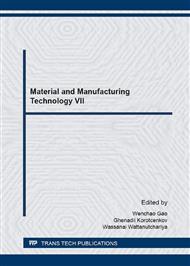[1]
H. Hu and Y. D Xu: The application and market analysis of metal-ceramic composite materials [J]. Metallic Functional Materials, (2013) No. 2, p.36. (In Chinese).
Google Scholar
[2]
Y. Wang: Research of brazing technology of Al2O3 ceramics and Kovar alloy [D]. Harbin Institute of Technology, (2006), p.1. (In Chinese).
Google Scholar
[3]
Z. J Zheng and X. Ling: Residual stress analysis of influence factors to brazing welding joint of glass and kovar alloy [J]. Chinese Quarterly of Mechanics, (2011) No. 2, p.239. (In Chinese).
Google Scholar
[4]
R.H. Leggatt: Residual stresses in welded structures[J]. International Journal of Pressure Vessels and Piping, Vol. 85 (2008) No. 3, p.144.
DOI: 10.1016/j.ijpvp.2007.10.004
Google Scholar
[5]
S.H. Li, G. Zeng, Y.F. Ma and Y.J. Guo: Residual stresses in roll-formed square hollow sections[J]. Thin-Walled Structures. (2009) No. 47, p.505. (In Chinese).
DOI: 10.1016/j.tws.2008.10.015
Google Scholar
[6]
G.L. Zhang, L. Shi and D.Z. Jin: Residual Stresses Distributions within Thin-Walled Ceramic-Metal Seal[J]. Advanced Materials Research, (2012), p.503.
DOI: 10.4028/www.scientific.net/amr.503-504.428
Google Scholar
[7]
Zhishui Yu, Pei Yang, Kai Qi and Ruifeng Li: Effects of Mo Interlayer on Suppressing Cracks in Al2O3/Kovar Brazed Joint Rare, Metal Materials and Engineering, (2008) No. 12, p.2118. (In Chinese).
DOI: 10.1016/s1875-5372(10)60009-4
Google Scholar
[8]
M. Rohde: Joining of alumina and steel by a laser supported brazing process. Ceramics International, (2009) No. 1, p.333.
DOI: 10.1016/j.ceramint.2007.11.007
Google Scholar
[9]
T. Kondoh, Tokimasa, T. Sasaki and Yukio Hirose: X-ray Stress Measurement for Titanium Aluminide Intermetallic Compound[J], Advances in X-ray Analysis, (2000) No. 43, p.107.
Google Scholar
[10]
A.T. Fry and F. A Kandil: A Study of Paramaters Affecting the Quality of Residual Stress Measurements Using XRD[J], Materials Science Forum, (2002), p.404, p.579.
DOI: 10.4028/www.scientific.net/msf.404-407.579
Google Scholar


